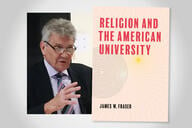You have /5 articles left.
Sign up for a free account or log in.
In 1953, while the Supreme Court was considering the school desegregation case Brown v. Board of Education of Topeka, Kan., Chief Justice Fred M. Vinson, who opposed overturning the court’s 1896 Plessy v. Ferguson “separate but equal” doctrine, died of a heart attack. Quipped Justice Felix Frankfurter, this was the first evidence he had seen to prove the existence of God.
Brown v. Board of Education is probably the one Supreme Court decision that virtually every schoolchild knows. But as recent scholarship has demonstrated, the case’s legacy is far more complex than that summed up in the title of the book Simple Justice, Richard Kluger’s classic National Book Award–winning 1975 account of the decision and its aftermath.
In recent years, many scholars have subjected the Brown decision to close critical scrutiny. Among the criticisms:
- The court allowed prolonged delays desegregating schools in the Southern and border states; as a result, many cities did not fully desegregate their school systems until the 1970s.
- The decision spurred white flight from urban centers, allowing whites to evade integration while exacerbating the problem of educational inequality.
- The court failed to address de facto segregation in the North and West, where Black students are now less likely to attend integrated schools than in the South.
Rather than seeing the decision simply through a triumphalist or racial progress lens, more recent scholarship has argued that Brown convinced many Northern liberals that racism was essentially a Southern phenomenon, that extremist resistance to desegregation was confined largely to white Southerners or to working-class bigots, and that legal changes were sufficient to address the nation’s racial divisions.
Without a doubt, the Brown decision did represent a historical watershed. It accelerated the civil rights struggle and provided impetus for the Civil Rights Acts of 1957 and 1964, the Voting Rights Act of 1965, and the Fair Housing Act of 1968. But by focusing exclusively on the de jure—the statutory—segregation of schools, the decision assumed that integration would entail nothing more than giving Black students in the South the opportunity to attend predominantly white schools, racism would somehow be overcome and equal opportunity achieved.
The high court ultimately proved reluctant to involve itself in the details of desegregation: about how to achieve greater racial balance in schools, how to ensure that Black parents and students would have an appropriate voice in designing curricula, and how to achieve greater Black representation among the teachers and school administrators.
Writing 50 years after the court decision, the Bancroft Prize–winning historian James T. Patterson of Brown University argued persuasively that in their efforts to speak with a united voice, the Supreme Court justices needlessly prolonged the desegregation process. Worse yet, their delay allowed neighborhoods and communities to resegregate without any judicial interference.
In 1979, J. Harvie Wilkinson, wow a judge on the Fourth Circuit Court of Appeals, wrote perhaps the most stinging analysis of the Supreme Court’s actions in the wake of the Brown decision. In From Brown to Bakke, he criticized the justices for dithering. By transferring responsibility for implementing the decision to 48 federal district courts and the Fourth and Fifth Circuit Courts, the results were predictable: inconsistency, delay and a lack of direction.
Ultimately, the Supreme Court failed to truly stand up for the principle it articulated in Brown—that all Americans have a right to equal education opportunity and that anything less than integrated classrooms is a violation of that right—and left the issue of inequality across school district boundaries to the states, where it remains.
Now, Leslie T. Fenwick, the author of Jim Crow’s Pink Slip: The Untold Story of Black Principal and Teacher Leadership, has added yet another criticism of the decision: that Brown permitted school districts across the South to close Black schools across the South and dismiss Black principals and teachers en masse.
Two new books, one by Gary Orfield, professor of education, law, political science and urban planning at the UCLA, where he codirects the institution’s Civil Rights Project; and another by Sandy Baum, a senior fellow at the Urban Institute and professor emerita of economics at Skidmore College, and Michael McPherson, president emeritus of the Spencer Foundation and Macalester College, offer powerful arguments about how society can “mitigate the worst consequences of America’s deeply seated inequalities.”
According to Orfield, higher education has become an instrument “for the perpetuation and even the deepening of stratification and inequality” that too often rations opportunity by price. If society is to effectively address racial inequalities, it must, he believes, take race into account, whether in tackling the financial barriers to academic success for many families of color and addressing glaring inequalities in educational preparation by race. Color-conscious policies like affirmative action admissions and financial aid “are by far the most direct and efficient ways of increasing access and success for students of color.”
Here’s what he recommends:
- Give students of color access to better schools. To address inequalities in educational preparation:
- Offer students of color the right to transfer to stronger high schools, including schools in other school districts.
- Change school assignment rules to enroll more students of color in schools with a middle-class majority.
- Target outreach and recruitment policies for magnet programs to communities of color.
- Admit students to selective magnet and other specialized schools by lottery and choice, not by screening.
- Set aside seats in selective magnet schools in ways that ensure that all neighborhoods are well represented.
- Use housing policy to increase educational opportunity. Since growing up in segregated, high-poverty neighborhoods often produces lifelong harms, institute programs that move families to areas with better schools.
- Address inequalities among high schools head-on. To create genuinely equal preparation at the precollegiate level, school districts must:
- Equalize access to advanced courses.
- Provide schools in high poverty areas with the funds needed to hire appropriate faculty.
- Expand outreach programs that allow high school students of color to take college classes or participate in summer programs at college.
- Provide comprehensive support services at both the K-12 and college levels. Integrated services need to include academic, personal, college application and financial aid counseling, and social worker support.
Colleges need to affirmatively address the needs of students of color. Proven strategies include:
- Targeted scholarships for students of color that are substantial enough to meet the full financial need of those from low-income households.
- Active college information and recruitment efforts in communities of color.
- Heightened attentiveness to the impact of campus policies on students of color, including policies that discourage transfers from community colleges.
Like Orfield, Baum and McPherson demonstrate that colleges, despite their commitment to equal opportunity, social mobility and racial justice, in fact produce and reproduce inequality. The authors do a masterful job of examining how differences in family structure, neighborhoods and elementary and secondary education negatively impact young people’s academic preparation and influence career aspirations, attitudes and behavior patterns.
Baum and McPherson argue that overcoming entrenched racial and class inequalities will require American society to prioritize investments precollege—in high quality preschool programs and child tax credits, for example—eliminate structural inequalities in labor markets (for example, through “better worker protections, a higher minimum wage, stronger unions, more on-the-job training for entry-level workers,” and invest more “in the postsecondary institutions that educate most low-income and marginalized students.”
Baum and McPherson are also certainly right that higher education isn’t a silver bullet that can single-handedly overcome societal inequities. But I’m glad that they highlight programs, like CUNY’s ASAP, that “can significantly increase student success at nonselective institutions that serve students who do not arrive with stellar academic credentials.”
So what are the policy implications of their analysis?
- Policy makers need to recognize that access is no longer the pre-eminent problem confronting higher education. Rather, the chief problem involves outcomes. Improving academic and postgraduation outcomes, they argue, will require significant improvements both in the quality of teaching and in the supports that institutions put in place. Regular and substantive interaction with an expert instructor, classmates and support staff are also essential, especially for students who received an uneven education in high school.
- Policy should focus not only on the cost of tuition, but on quality. A cost focus tends, ironically, to benefit more affluent students and their families. Irrespective of cost, students, especially those from low-income backgrounds, are ill served by programs “that do not provide the guidance, support and learning opportunities they need to achieve their goals.” A top policy priority must be to provide less selective institutions with the resources they need to properly and effectively serve students who arrive with uneven preparation and multiple academic and nonacademic needs.
- Policy makers should reject the idea that online education can successfully improve outcomes for students who were traditionally closed out of high-quality learning opportunities. Students with weak academic backgrounds and other risk factors struggle most in fully online courses, creating larger socioeconomic gaps in outcomes than those in traditional classroom environments. The central problem appears to be the lack of adequate personal interaction between students and instructors, as well as among students.
- Policy makers need to pay more attention to the full cost of attendance. For full-time students at public four-year institutions, tuition and fees only account for 39 percent of the total cost of college.
- Policy makers should invest more financial resources into the broad-access institutions that serve the largest number of disadvantaged students. To maximize impact, policy makers need to make greater investments in the postsecondary institutions that educate most low-income and marginalized students rather than just getting more students from these backgrounds into the most prestigious colleges and universities. But these underfunded institutions need the resources to create an environment in which their students can thrive.
- Policy makers should reconsider the widespread belief that students from low-income backgrounds benefit most from an education that is narrowly vocational. Instead, the authors stress the importance of ensuring that graduates can communicate well, solve problems effectively, cope with uncertainty and develop a capacity to acquire new skills.
- Policy makers should hold institutions more accountable for student outcomes not through performance-based funding but through incentives that go beyond enrolling more students. Among the initiatives that Baum and McPherson favor are corequisite remediation, intrusive advising and guided pathways.
- Policy makers should encourage the development of constructive alternatives to college. These alternatives might include expanded career and technical education, apprenticeship opportunities, and support for on-the-job training.
In today’s dispiriting environment, the prospects for effectively addressing racial and class inequalities strike many of us as particularly unlikely. Although some of the prescriptions in The Walls Around Opportunity and Can College Level the Playing Field? may appear somewhat fanciful and unrealistic, the authors have a remarkable track record of identifying and promoting policies that are eventually enacted.
After reading these books, you’ll never again be able to say that no one has advanced a concrete scheme to address this society’s deep-seated educational inequities. The problem before us is not a shortage of ideas. It’s a problem of will, persuasion, determination and implementation.
If we fail to follow their recommendations, shame on us.
Steven Mintz is professor of history at the University of Texas at Austin.



